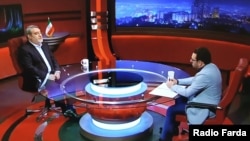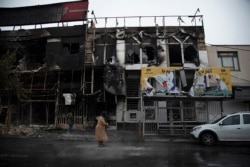The Islamic Republic Minister of Interior says that the recent protests across Iran turned into "special" cases of intense unrest in five provinces of the country. One hundred spots in the capital city, Tehran, were also the scene of intense protests.
Speaking to the state-run monopolized Channel One TV on Tuesday evening November 26, Abdol Reza Rahmani Fazli disclosed, "Most of the anti-regime protests occurred in the suburbs and impoverished margins of the cities."
Rahmani Fazli, who presides over the country's National Security Council, named the oil-rich province of Khuzestan as one of the provinces where the recent protests turned into "special" cases of intense anti-regime rallies.
Nearly eighteen cities of Khuzestan, southwest Iran, witnessed widespread protests, Rahmani Fazli said, adding without elaboration that the provinces of Fars, Isfahan, and Tehran also experienced "special cases" of vigorous demonstrations.
Out of 31 provinces of Iran, Rahmani Fazli revealed only four were calm.
Neighboring cities west of the capital, including Baharestan, Malard, Shahriar, and Shahr-i Qods, were the scene of especially intense demonstrations, Rahmani Fazli noted.
Earlier, pro-reformist representative of the city of Damavand to Majles (parliament), Qassem Mirzaei Nekou, had revealed that more than 500 regions in Iran experienced furious protest, while the security forces killed more than 130 during clashes with the demonstrators.
Nonetheless, without any reference to the number of victims, the Interior Minister claimed that the number of injured security forces was twice as much as casualties among protesters.
While most of what Rahmani Fazli revealed about locations and concentration of protests correspond to other reports, the interior minister continued to withhold information on who authorized the use of lethal force against protesters and exactly how many were killed, injured and arrested.
Meanwhile, in its latest report on Iran, Amnesty International (AI) says that at least 143 fell victim to the security forces' violent response to the protests.
Latest figures mentioned by lawmakers indicate the Islamic Republic security forces arrested at least 7,000 in eighteen provinces, during the demonstrations that initially held against an overnight three-fold increase in gasoline prices.
In what was a disturbing statement, Rahmani-Fazli insisted that those arrested should confess on TV to what they have done during the protests. Iranian TV is known for airing forced confessions under duress.
Speaking to the state-run TV, Rahmani Fazli also maintained that the protesters set fire to 731 banks, 140 public buildings, nine religious sites, seventy gas stations, 307 vehicles, and 1,076 motorbikes.
However, many protesters have repeatedly noted that plainclothes agents embedded among the demonstrators had been responsible for such attacks, giving an excuse to the security forces to brutally suppress people who were merely protesting the unprecedented price hike.
Furthermore, Rahmani Fazli claimed that 500 were marching toward Seda va Sima (Persian for the Voice & Vision, or Radio-TV station) in Tehran, but were stopped by the security forces.
"Protests were triggered on Friday evening, November 15, immediately after the government announced the increase in gasoline prices," Rahmani Fazli affirmed, adding, "But from Saturday morning the nature of the protests swiftly changed into an intense political and subversive demonstration."
Facing an growing anti-regime protests, Rahmani Fazli said, the Interior Ministry initially restricted, and then totally denied people's access to the internet.
In the meantime, Rahmani Fazli said that the protesters blocked Mahshahr to Bandar Imam road in the south for three consecutive days.
Tehran-Karaj freeway, Mazandaran-Mashhad, and Jam-Assalouye roads were also among the routes blocked by the protesters, Rahmani Fazli claimed.







